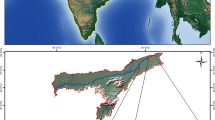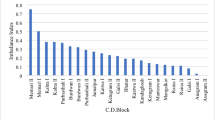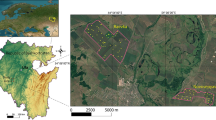Abstract
Soil loss is a significant threat in both onsite and offsite issues of worldwide, and more attention is required to compensate for the soil loss, loss of fertility, nutrients, valuable minerals, and silt deposition in reservoirs. The geographical distribution of soil loss was evaluated using the Universal Soil Loss Equation (USLE) model, and trapezoidal equation used to assess sediment deposition. From USLE equation, the maximum spatial distribution of soil depletion is 60 tonnes/hectare/year, whereas the sediment yield assessment through the reservoir is 57 t/ha/year. From multiple and temporal satellite datasets, it is found that the rate of silt deposition is 5.21 Hm/100 sq km/year. Many researchers used methods to assess the soil loss or yield separately but have yet to integrate them into a single environment. To fulfil the gap, chosen Kaddam watershed computed two methods separately, integrated simulations and compared with the observed hydrographic survey shown satisfactorily. Hence, the prediction and method of the present study can adopt other reservoirs.










Similar content being viewed by others
References
H.S. Gelagay, A.S. Minale, Soil loss estimation using GIS and remote sensing techniques: A case of Koga watershed, Northwestern Ethiopia. Int. Soil Water Conserv. Res. 4(2), 126–136 (2016). https://doi.org/10.1016/j.iswcr.2016.01.002
L.C. Kulimushi, P. Choudhari, L.K. Mubalama, G.T. Banswe, GIS and remote sensing-based assessment of soil erosion risk using RUSLE model in South-Kivu province, eastern, Democratic Republic of Congo. Geomat. Nat. Haz. Risk 12(1), 961–987 (2021). https://doi.org/10.1080/19475705.2021.1906759
Chandramani, L., Oinam, B. Soil loss assessment in Imphal river watershed, Manipur, North-East India: a spatio-temporal approach, in Lecture Notes in Civil Engineering, vol. 39, pp. 81–101 (2020). https://doi.org/10.1007/978-981-13-8181-2_7
A. López-Pérez, D.S. Fernández-Reynoso, Watershed prioritization using morphometric analysis and vegetation index: a case study of Huehuetan river sub-basin, Mexico. Arab. J. Geosci. (2021). https://doi.org/10.1007/s12517-021-08212-x
V.J. Markose, K.S. Jayappa, Soil loss estimation and prioritisation of sub-watersheds of Kali River basin, Karnataka, India, using RUSLE and GIS. Environ. Monit. Assess. (2016). https://doi.org/10.1007/s10661-016-5218-2
M.C. Singh, K. Sur, N. Al-Ansari, P.K. Arya, V.K. Verma, A. Malik, GIS integrated RUSLE model-based soil loss estimation and watershed prioritization for land and water conservation aspects. Front. Environ. Sci. 11, 1136243 (2023). https://doi.org/10.3389/fenvs.2023.1136243
W.H. Wischmeier, D.D. Smith Predicting Rainfall Erosion Losses. A Guide to Conservation Planning. The USDA Agricultural Handbook No. 537, Maryland (1978)
A. Goumrasa, M. Guendouz, M.S. Guettouche, D. Akziz, H. Bouguerra, Spatial assessment of water erosion hazard in Chiffa wadi watershed and along the first section of the Algerian North-South highway using remote sensing data, RUSLE, and GIS techniques. Arab. J. Geosci. 14(20), 2152 (2021). https://doi.org/10.1007/s12517-021-08377-5
J.R. Williams, Flood routing with variable travel time or variable storage coefficients. Trans. ASABE 12, 100–103 (1969)
K.G. Renard, G.R. Foster, G.A. Weesies, J.P. Porter, RUSLE: revised universal soil loss equation. J. Soil Water Conserv. 46(1), 30–33 (1991)
A. Kodimela, S. Sivaprakasam, S. Parupally et al., Soil loss and reservoir sedimentation assessment of Kaddam watershed using geographical information systems and remote sensing techniques, 03 January 2023, PREPRINT (Version 1) available at Research Square. https://doi.org/10.21203/rs.3.rs-2408470/v1
M.C. Singh, K. Sur, S. Satpute, V. Prasad, S. Singh, Geospatial techniques and PCA-based prioritization of reservoir catchments located in Shivalik foot-hills of Indian Punjab for land and water conservation. Water Pract. Technol. (2023). https://doi.org/10.2166/wpt.2023.105
S. Parupalli, K.P. Kumari, S. Ganapuram, Assessment and planning for integrated river basin management using remote sensing, SWAT model and morphometric analysis (case study: Kaddam river basin, India). Geocarto Int. 34(12), 1332–1362 (2019). https://doi.org/10.1080/10106049.2018.1489420
P. Sridhar, S. Ganapuram, Morphometric analysis using fuzzy analytical hierarchy process (FAHP) and geographic information systems (GIS) for the prioritisation of watersheds. Arab. J. Geosci. 14(4), 236 (2021). https://doi.org/10.1007/s12517-021-06539-z
S. Wagh, V. Manekar, Assessment of reservoir sedimentation using satellite remote sensing technique (SRS). J. Inst. Eng. India Ser. A 102(3), 851–860 (2021). https://doi.org/10.1007/s40030-021-00539-8
A. Pandey, U.C. Chaube, S.K. Mishra, D. Kumar, Assessment of reservoir sedimentation using remote sensing and recommendations for desilting Patratu Reservoir, India. Hydrol. Sci. J. 61(4), 711–718 (2016). https://doi.org/10.1080/02626667.2014.993988
L. Tsegaye, R. Bharti, Soil erosion and sediment yield assessment using RUSLE and GIS-based approach in Anjeb watershed, Northwest Ethiopia. SN. Appl. Sci. 3, 582 (2021). https://doi.org/10.1007/s42452-021-04564-x
I.D. Moore, G.J. Burch, Physical basis of the length-slope factor in the universal soil loss equation. Soil Sci. Soc. Am. J. (1986). https://doi.org/10.2136/sssaj1986.03615995005000050042x
M. Meliho, A. Khattabi, N. Mhammdi, Spatial assessment of soil erosion risk by integrating remote sensing and GIS techniques: a case of Tensift watershed in Morocco. Environ. Earth Sci. (2020). https://doi.org/10.1007/s12665-020-08955-y
Funding
The authors have not disclosed any funding.
Author information
Authors and Affiliations
Corresponding author
Ethics declarations
Conflict of interest
The authors have not disclosed any competing interests.
Additional information
Publisher's Note
Springer Nature remains neutral with regard to jurisdictional claims in published maps and institutional affiliations.
Rights and permissions
Springer Nature or its licensor (e.g. a society or other partner) holds exclusive rights to this article under a publishing agreement with the author(s) or other rightsholder(s); author self-archiving of the accepted manuscript version of this article is solely governed by the terms of such publishing agreement and applicable law.
About this article
Cite this article
Anil, K., Sivaprakasam, S. & Sridhar, P. Soil Loss Evaluation in Kaddam Watershed Using Geographical Information Systems and Remote Sensing Techniques. J. Inst. Eng. India Ser. A 104, 997–1003 (2023). https://doi.org/10.1007/s40030-023-00753-6
Received:
Accepted:
Published:
Issue Date:
DOI: https://doi.org/10.1007/s40030-023-00753-6




